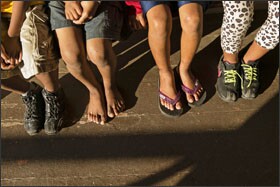Sixty-five miles from the nearest town of Hilo, over the volcano and past groves of coffee and macadamia-nut trees, is Naalehu Elementary School. Here, students travel as far as eight miles along privately owned roads to reach the closest school bus stop on the main highway, contributing to chronically high absenteeism.
Children from the Marshall Islands, a U.S. territory where the American military tested nuclear weapons during the Cold War, come to escape poverty and contamination, and often arrive at school with health problems and little English.
Naalehu Elementary is a training ground for new teachers, who typically do two years of duty, get tenure, and then leave for schools in larger towns on the Big Island of Hawaii, or on Oahu.
The 459-pupil school and the others in what’s known as the Kau-Keaau-Pahoa complex area are among the primary beneficiaries of a $75 million Race to the Top grant, part of an intensive state and federal effort to transform Hawaii’s school system from one of the nation’s worst, by some metrics, to one of its most improved.
Just two years ago, the state was floundering so badly in executing its plan that it nearly lost the coveted grant. Today, it looks as if the federal bet may pay off.
“We pushed real fast and real hard,” said state Superintendent Kathryn Matayoshi. “Now, it’s a question of time. It’s giving people time to love it and learn it and practice it,” she said of the state’s aggressive Race to the Top agenda.
This geographically challenging state—an eight-island chain 2,400 miles off the coast of California—features a single, state-run school district of 185,000 students, with 255 schools in all. One million of its 1.3 million residents live on Oahu, which includes Honolulu, meaning a large swath of Hawaii is extremely rural—and its schools very remote.

So in this way, Hawaii shares many of the challenges of other Race to the Top states, with both poor urban centers and isolated rural communities.
Despite such difficulties, Hawaii has made a relatively controversy-free transition to the Common Core State Standards, developed an enviable new data-driven culture among educators, seen early progress in its turnaround schools, and posted impressive test-score gains—all since winning its federal grant three years ago.
Consider Hawaii the come-from-behind character in the Obama administration’s Race to the Top story.
“Lots of folks sort of scoffed when we invested in Hawaii through Race to the Top. People thought that was a loser, that Hawaii could never do anything. ... Hawaii, to their tremendous credit, has proved a lot of skeptics wrong,” U.S. Secretary of Education Arne Duncan said in a media call Nov. 7 praising Hawaii’s significant improvement on the National Assessment of Education Progress.
From ‘Disastrous’ to ‘Successful’
The 2013-14 school year is the final year of implementation for the 12 states that shared $4 billion in grants as part of a program that will likely be central to the education legacies of President Barack Obama and Mr. Duncan. There is little doubt that supporters, along with critics who debated the value of spending billions on an education competition, will be eyeing Hawaii and the other Race to the Top grant winners in assessing the outcome of the administration’s education agenda.
At Keaau High School on Hawaii’s “Big Island,” the principal utilized federal Race to the Top money to help turn around a low-performing school. Read more.
Hawaii came out of nowhere to win its grant in 2010. The Obama administration devised the contest, financed with 2009 economic-stimulus money approved by Congress, to spur change in four areas: standards and tests, data systems, educator effectiveness, and low-performing schools.
Virtually no one—not federal education officials and not the Hawaii grant-proposal writers—had thought the Aloha State was a favorite to win. In fact, when Superintendent Matayoshi got the call as she was leaving for work on an August morning telling her that Hawaii won a grant, she was so shocked that she drove into her husband’s car in their driveway.
And the state seemed to prove the doubters right when, less than a year later, federal officials threatened to take its grant away over widespread problems of implementation, particularly with teacher evaluations.
Among the many problems: The state education department wasn’t organized in a way to carry out such a bold, high-profile plan. Its officials struggled with a heavily front-loaded agenda that promised a lot in the first two years for a state that even educators acknowledge operated without a sense of urgency.
So Ms. Matayoshi did two key things: She overhauled her leadership team and tapped Stephen Schatz, a former teacher and complex-area superintendent whose on-the-ground battle scars gave him credibility with rank-and-file teachers, and put him in charge of Race to the Top efforts in August 2011. And she ingrained Race to the Top into educators’ everyday work, turning Hawaii’s proposal into the state board of education’s adopted strategic plan.
Although the state’s Race to the Top plan is outlined in a 220-page document, it can be boiled down to a two-pronged mission: transform the K-12 culture into one driven by data, and raise expectations for students, educators, and administrators across all the islands—whether in struggling rural schools like Naalehu Elementary or more successful schools in the wealthy ZIP codes of the beach-filled Windward Coast of Oahu.
Hawaii’s work, strongly backed by Gov. Neil Abercrombie, a Democrat, has even turned some hard-nosed Washington insiders into believers.

The NAEP scores alone are reason enough to pay attention to what Hawaii is doing, said Michael J. Petrilli, a vice president of the Thomas B. Fordham Institute, a Washington think tank, and a former education official in President George W. Bush’s administration. When the Race to the Top winners were announced, he picked on Hawaii in particular and called its selection a “disastrous outcome.”
Now, he said, “Hawaii’s education leaders deserve a lot of credit for pushing ahead with a coherent, bold reform agenda.”
“Hawaii, with its unitary system, has always had the potential for successful standards-based reform,” Mr. Petrilli said. “It appears to finally be living up to that potential.”
To be sure, the state still has a long way to go. Although its NAEP scores show big improvement in math, especially, its reading scores—although improved—are still among the nation’s worst.
Big Island, Big Challenges
Hawaii’s K-12 structure is distinctive: The single system spans the state’s wildly diverse islands, with 15 “complex areas.” (Think of a complex area as a district in the traditional K-12 governance structure.) The District of Columbia, also a Race to the Top winner, has the only other “statewide” system in the country.
In Hawaii, Race to the Top aid has created additional preschool classes, extended learning time for students deemed at risk of academic failure, a more sophisticated teacher-induction program, and aligned data systems that can now be accessed with a single logon.
But Hawaii’s Race to the Top initiative is as much about a shift in mindset as it is about implementing certain programs or buying products for schools and students.
“What we’ve started here is about effective teaching and effective leading. It’s not about fancy tools. It’s not something that we bought,” said Ronn Nozoe, the deputy state superintendent. “There’s a lot of pain and suffering. It’s a heavy lift, and that’s hard.”
At Kanoelani Elementary, a 785-student school in Waipio on the island of Oahu, the common core is being integrated into a school that prides itself on a cohesive approach to learning across grade levels. Read more.
The state has created several layers of tactical teams that are in charge of making Race to the Top come to life in every school.
A complex-area-support team, or CAST, of 75 educators, paid for in part by Race to the Top dollars, is made up of specialists in implementing all the “big bet” state strategies: the common-core standards, comprehensive student supports, data teams, educator-effectiveness systems, teacher and leader induction and mentoring, and academic-review teams.
Then, those academic-review teams—found in each complex area and school—serve in a cabinet-like advisory role to leaders to make sure strategies are working and to plot course corrections as needed.
And finally, grade- and department-level data teams of teachers look at trends, problem spots, and success across, for example, all 3rd grade math classrooms.
Race to the Top in the state is perhaps best showcased in the Kau-Keaau-Pahoa, or KKP, complex area, one of two “zones of innovation” that house Hawaii’s lowest-performing schools, and that have received the most attention, money, and resources.
The challenges across this chunk of the Big Island are huge: Up to 49 percent of students are chronic absentees; 86 percent are poor enough to qualify for free or reduced-price school meals; half don’t have Internet access at home; 47 percent are Native Hawaiian and hundreds more are immigrants from the Marshall Islands, who must overcome significant language, cultural, and financial barriers.
That’s not to mention the gas plumes from the still-active Kilauea volcano, which contribute to high rates of asthma and other respiratory diseases.
Armed with the power and money of Race to the Top, complex-area Superintendent Mary Correa launched a three-pronged attack: improve the quality of leaders and teachers in an area of the Big Island that has a huge recruitment problem, find ways to extend learning time for students, and address the lack of early education by implementing new preschool programs. To help make that happen, she brokered a three-year contract with School Synergy, an Oregon-based school turnaround group.
“I can’t spend my effort getting parents jobs or getting them health care,” said Ms. Correa, who runs a war room for the school improvement effort out of a renovated garage, and liberally doles out cough drops to ward off coughing fits caused by the volcanic gases. “I spend my effort on what I can control.”
Teacher Training Ground
Hawaii’s biggest Race to the Top roadblocks came in putting in place new teacher evaluations tied to students’ academic growth.
That move touched off a protracted spat with the state teachers’ union that lasted almost two years and nearly cost the state its federal grant.
And now, the state has to implement the evaluation plan among rank-and-file teachers, whose buy-in is crucial. (It helps that as part of the new contract, teachers got recession-era pay cuts restored, plus additional salary increases.)

“We have so much on our plates,” said Sheila Bradley, a student-support specialist at Naalehu Elementary School. New “student learning objectives” that teachers work on in concert with their principals are particularly time-consuming, she said.
“To add [those objectives] to prove that we are effective—to me that seems questionable,” Ms. Bradley said.
Ms. Correa, of the KKP complex area, knows it’s a lot. But, she said, her complex area had a lot of room to improve. In 2008, just 50 percent of her area’s teachers in the core subjects met the “highly qualified” definition under the No Child Left Behind Act, she said; now, it’s 80 percent. (The national average is 97 percent.)
Every year, the state must find 700 to 1,000 teachers to replace those that retire or leave the profession; the K-12 teaching field employs about 12,000 teachers.
And a lot of the vacancies are in schools like Naalehu Elementary, whose location about an hour from the nearest sizable town makes for a long haul when gas can top $4 a gallon and beginning teachers make about $40,000 a year.
“We feel like we’re a training ground,” said Assistant Principal Karen Pare. “It’s frustrating sometimes. But at least we know we’re training them well.”
For that reason, says state Superintendent Matayoshi, Hawaii “isn’t a place where you just throw people away. You help them. You provide a safe place for them to get better.”
For those in the KKP complex area, that means that new teachers are each assigned a community member to serve as a “cultural mentor.” They take part in group activities, such as learning to paddle a canoe in a quiet part of the Pacific. The goal: To foster teamwork and to introduce a new cadre of teachers, many of whom are not Native Hawaiian, to the cultures of their students.
What’s more, KKP superintendent Ms. Correa created perhaps the state’s strongest teacher-support team of school leaders. These teams observe every teacher in her schools twice a month and provide feedback, which has nothing to do with the official high-stakes evaluation process.
Keaau Elementary School in Hawaii used its status as a Race to the Top “zone of innovation” school to raise money to give each student a computer. Read more.
The pace of change in Hawaii, for teachers and administrators alike, is intense. Teachers are not only implementing the common core, but also new tests aligned to the standards, on top of being subject to the new evaluations.
“The amount of components being done at the same time is a huge challenge,” said Stacie Kunihisa, the principal of Kanoelani Elementary School, on Oahu. She has a stack of binders that would reach almost to the ceiling that contains various data sets, mission plans, and curriculum tools driving her work.
“There’s a lot of pressure on schools,” she said. “I’m drowning.”
But, Ms. Kunihisa said, “this is bigger than Race to the Top. It’s knowing you are moving as a school.”
Funding Cliff
In another year or so, however, all of the Race to the Top money will be gone, and Hawaii’s underlying school funding concerns will loom ever larger.
The state’s economy and its aid for schools are tied to tourism, an industry that is especially sensitive to economic conditions. Visitors spent $14 billion in 2012, a big uptick from the depths of the recession, when in 2009 they spent just under $10 billion. A little more than $1 billion of that goes directly into the state’s coffers in the form of tax revenue.
And for better or for worse, Hawaii’s fate is determined not just by U.S. economic forces, but by the Japanese economy as well. So when a tsunami hit Japan in 2011, and Japanese visitors to Hawaii dwindled, the state budget also took a hit. All of this affects the public schools, which are entirely state-funded, except for the roughly 14 percent that comes from federal sources.
Because of state budget woes, Hawaii had to cut 17 school days for students in 2009-10. For this fiscal year—2013-14 and the next—the legislature cut a combined $25 million from the Hawaii Department of Education’s administrative budget at a time when state officials are implementing Race to the Top, a new NCLB-law waiver, and the common-core standards and tests. Only this year have teachers had their pay cuts from the Great Recession reversed.
For all of these reasons, sustainability of Race to the Top improvements is a big issue. That’s evident in how Ms. Pare at Naalehu Elementary frets about the additional preschool class that Race to the Top provided.
“A lot of our kids are just not ready for kindergarten. We were retaining 25 [percent] to 50 percent of our kindergartners before we started this,” Ms. Pare said. Once Race to the Top aid runs out, the school will need additional state money to keep preschool classes open, she said.
Expensive Move
Last year, the state’s lowest-performing “zone” schools added nearly an hour a day, for four days a week, for extended learning time—also an expensive proposition.
With that, Naalehu Elementary added a 45-minute intervention period at the beginning of the school day. Janice Ogi, who became the school’s data coach through Race to the Top, pored over the data, working with teachers to group students by need, and not by grade level. Students who needed help with phonics went to one classroom; students who needed help with fluency went to another.
“Before, we’d focus on the ‘bubble’ kids,” Ms. Ogi said, referring to the students who were just on the edge of becoming “proficient” under No Child Left Behind Act standards. “But now we’re looking at every child.”
But, in the long term, continuing that broad emphasis would carry a significant price tag.
“This was all teachers, all kids. Everybody, every day. That has a bigger price tag, and in the long run, there were questions about whether that was affordable,” Mr. Schatz, the state’s assistant superintendent for strategic reform, said.
So the state decided to scale that initiative back and get schools to target extended learning time to the neediest students.
These sustainability questions might mean Hawaii’s improvement efforts could be tenuous. For the state education department, building stronger ties with private foundations will be critical to the long-term stickiness of the Race to the Top work.
“This really pushed us to act like a system. And that’s key,” said Alex Harris, a former state education department official who is now the senior program officer for education at the Kailua-based Harold K.L. Castle Foundation, which finances a variety of education and environmental projects in Hawaii. “We’ve made really good gains, but they’re fragile.”





